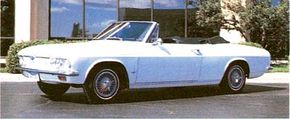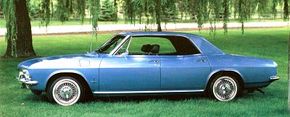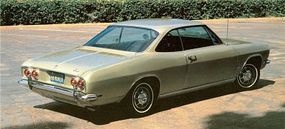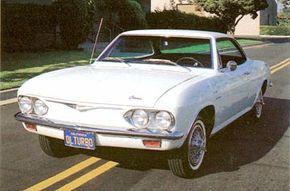The Corvair died a tragic death, kept in production only long enough to amortize the die expenses of the second generation (1965) redesign. But its spirit lived on as the model evolved into the 1965-1969 Chevrolet Corvair Corsa and Monza.
Advertisement
Contrary to myth, the Corvair was not scrubbed because of Ralph Nader's attacks. Chevrolet documents examined by several writers prove that the word had been passed to start development of a conventional front-engine, rear-drive car in 1964, before the new Corvairs hit the streets. This was likely prompted by the phenomenal success of the Mustang, introduced in the spring of that year, as it was well before Nader's book was published.
Nevertheless, the 1965 Corvair was a stunning automobile -- one of the few that look good from virtually any angle. "It is simply not possible to photograph this car from an angle that makes it look ugly," said one veteran automotive photographer. "I don't know any other mass-production car from its period that you could say that about."
A tribute to Bill Mitchell's brilliant staff at GM Styling, the new Corvair looked like the work of one of the leading Italian houses. It was nicely shaped, but not overdone, with just the right amount of trim.
It was new under the skin, too, with a turbocharged model, the Corsa, producing an unprecedented 180 horsepower, and a new non-turbo with 140 horsepower. Important too was its new rear suspension, a virtual copy of the Corvette Sting Ray's: upper and lower control arms, the uppers doubling as axle half-shafts, the lowers being unequal length non-parallel bars. These four arms controlled all lateral wheel motion. The sole difference from the Corvette was the use of coil springs, whereas the Corvette had a transverse leaf spring.
No longer was there any question about tricky handling on hard corners. The Corvair's handling was now virtually neutral, with mild final oversteer at very high speeds. Attention was also paid to the front suspension, which was tuned to complement the new rear design and to provide roll stiffness.
Read about Corsa and Monza performance characteristics on the next page.
For more information on cars, see:
- Classic Cars
- Muscle Cars
- Sports Cars
- Consumer Guide New Car Search
- Consumer Guide Used Car Search
Advertisement



